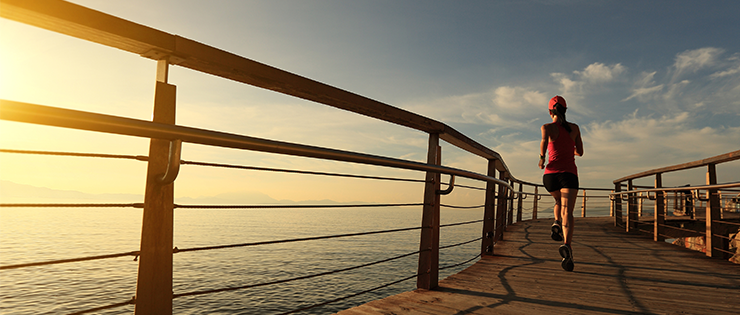
For many people summertime brings longer days and warmer nights which are the perfect opportunity to add some extra miles to the training regime. For others it’s a time when the running shoes finally get dusted off after spending the winter months in the back of the closet.
For me, being able to lace up my trainers & head out for a run around the park is one of the best feelings. It gets my heart rate up, works my legs like nothing else & it’s also a total head space cleanser.
Running is a full body workout, every muscle in your legs has to work hard, your core muscles are firing, so are your abdominals, lower back and even the muscles in your upper thoracic region & shoulders are active during the motion of running.
A few of my tips to effectively run through a hot summer are:
Run smart
Ideally don’t pick the hottest part of the day to go running. Early morning or later evening are generally the best times (and in my opinion also the prettiest times to run). As summertime progresses you may need to start 10-15 minutes earlier or later each week to beat the heat as the days get slightly longer! If you have no alternative to a lunch break training session try and find a running route with some shade. Asphalt & concrete surfaces absorb heat & will radiate it directly onto you, trail runs and grassy surfaces are cooler alternatives.
If you usually run on a treadmill inside where there is air conditioning it’s really important to acclimatise your body to the hotter weather outside. For example your first couple of weeks training out in the elements I’d suggest slightly shorter running distances, and slowly progress as tolerated. This will also help with the transition from consistent treadmill terrain to the undulating surfaces that you will face with running outdoors, this can be quite a challenge for the body and may take a little adjusting.
If you are starting a new running program, a progressive approach will be important to preventing injury. Just because you were able to easily knock over a 10km last summer doesn’t mean you can pick up where you left off. Start with an easy paced 20 minute run and the build from here. If you do start to feel a niggle don’t run through it, many running related issues are due to overload of certain structures so check in with your physio to see what’s going on. They can provide advice regarding footwear, loading and specific strengthening exercises that may need to be incorporated into your training.
Be prepared
Hat, sunscreen, sunglasses and water. If you are running longer distances a camelpak or waterbelt is a great idea but for those that don’t run with water you can plan your run to ensure that you will pass by a bubbler for a water pit stop. I’d also recommend breathable material. Cotton can absorb twice its weight, so as you sweat your cotton shirt will soak it up and provide absolutely no cooling effect to your body making it harder to keep your core temperature down.
Recover
Training in hotter conditions can be hard work. Give back to your body with some daily mobility and stretching. I personally love a good trigger ball session focusing especially on my calves, glutes and hips. 5-10 minutes per day is more than adequate.
Be mindful
Know the signs and symptoms of some heat related conditions such as dizziness, light-headedness or feeling weak. If you do find yourself in such a situation stop, find a cool spot to rest & sip on water. Summer is not the time to push the intensity of your running, listen to your body and pull back when you need too.
Running is a great form of exercise when you run smart and look after your body.